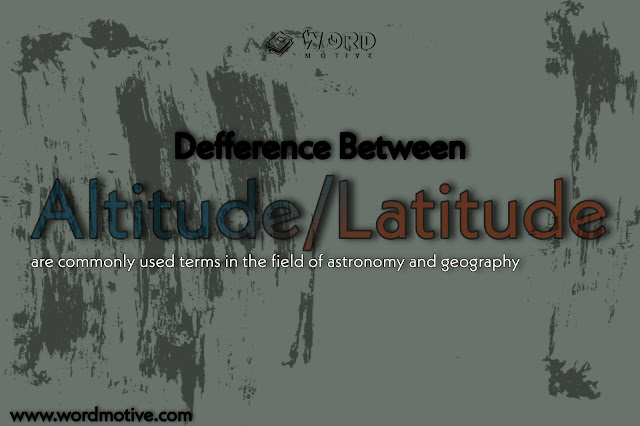Deference between Altitude and Latitude
Altitude and Latitude are commonly used terms in the field of
Astronomy and
Geography.
Both are parameters relating to the angular position of a location.
-
Altitude
It’s height. But it’s height relative to a reference point. Usually, there are two different reference points and thus two different altitudes for the same spot.
-
MSL Altitude - Mean
Sea Level Altitude is the height of the instrument (altimeter),
thing, or person relative to sea level. In other words, how high is the point being measured relative to the ocean’s surface?
- AGL Altitude - Above Ground Level. This is the same principle, but different in that measures the height above the ground directly below the reference point.
The aircraft is 20,000 feet higher than the ocean’s surface, but if you look out the window, the ground would only be 5,500 feet below you. That’s AGL altitude.
There is another altitude that is used by pilots but can affect non-pilots as well. It’s known as Density Altitude and it’s essentially the pressure the altitude that a person or aircraft (or car) might think it’s based upon temperature and air pressure. Higher Density Altitudes have the same effect on people and automobile engines - they don’t get as much oxygen and as a result, don’t work as well.
Example: Phoenix Arizona is known for being very hot in the summer. For the purposes of this explanation, call Phoenix’s altitude 1,106 feet MSL. On a HOT summer day, the heat effect on Density Altitude can make a person or engine feel like it’s 10,000 feet above sea level.
On a hot day, it’s not unusual for the California coastal airport I operate from which is at 163 feet MSL to have a “Density Altitude” of 400–700 plus feet.
-
MSL Altitude - Mean
Sea Level Altitude is the height of the instrument (altimeter),
thing, or person relative to sea level. In other words, how high is the point being measured relative to the ocean’s surface?
-
Latitude
In geography, latitude is defined as the angular distance of any point, north or south of the equator, i.e. it is a coordinate system, that is used as a reference point to locate places on earth.
The Equator is an imaginary circular line drawn on the earth, which divides it into two equal parts, wherein the upper half is called Northern Hemisphere and the lower half is known as Southern Hemisphere. The circular lines, parallel to the equator, up to the North and South poles are the parallels of latitude.
Latitude ranges from 0 degrees to 90 degrees, wherein the equator indicates 0° latitude and 90° is at the poles. The parallels lying in the northern hemisphere are considered as north latitudes, while those lying in the southern hemisphere are called South hemisphere.
Some major parallels of latitude are:
- Tropic of Cancer (23.5° N)
- Tropic of Capricorn (23.5° S)
- Arctic Circle (66.5° N)
- Antarctic Circle (66.5° S)
What is the difference between Altitude and Latitude?
- The latitude is a measure from the equator, giving how high a point is located on the globe above the equator.
- The term altitude can be used in several cases;
- The height to a point from a datum line. (Geography and aviation)
- The angular position above the horizon of an observer. (Astronomy)
- The latitude is an angular measurement, hence given is degrees; together with longitude, it is used to give exact coordinates of the position of a location.
- The altitude (in aviation) is the height to a point in the atmosphere, therefore, measured in units of length, such as meters.
- The altitude used in astronomy is also an angular measurement from the horizon, therefore, measured in degrees.











